A reader named Paul sent me these photos of a very odd pistol that was allegedly found in Germany during WWII. In fact, this is a very rare Ross automatic pistol, patented in 1903 by Charles Ross, of the Ross Rifle Company in Quebec. It is a short recoil, toggle locked design, made for the .45 Ross proprietary cartridge (although efforts were made, unsuccessfully, to make a .45 ACP version for the US 1907 pistol trials).
This one has a somewhat crudely stamped “GL” on its barrel (see the last photo), which I suspect originated at the same time as the story about it being found in Germany. I would guess that an unscrupulous owner (who may or may not have known what the gun actually was) make up the German origin story and added the GL marking in an effort to pass the gun off as a very expensive prototype Luger of some sort. After all, it is a toggle-locked pistol, and to most people that is only associated with Lugers.
Anyway, I thought the photos would be good to publish, as I just recently filmed a video on another example of a Ross A-2 pistol which these will be good to compare with. That video will publish in probably a month or so, after the upcoming series of videos from Rock Island.

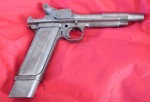
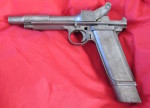
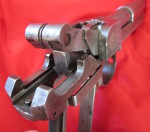
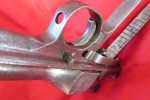
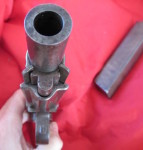
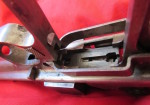
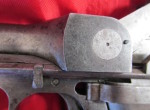
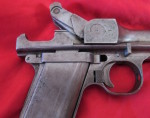
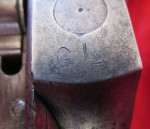
¡AMAZING!
NEW STAR WARS BLASTER PISTOL
Speculation time!
so how does it work?
my best guess from the photos is that right now it’s frozen halfway through cycling, that when fully in battery the knee joint sits behind the breachblock, upon firing the ramped surfaces visible in photo 3 (top Right) will kick the knee into the position it is now, unlocking the pistol, allowing the breachblock to slide under the knee. If that is the case then the gun is reversed from the typical toggle lock; the gun is locked and in battery when the knee is folded, and unlocked and open when the knee is straight. The only part I don’t have a theory on is how the fire control mechanism operates.
Anyone have any additional theories or info?
The toggle sort of resembles the later M1907/12 Schwarzlose HMG.
As I see it…
It’s fully locked in battery. When fired, the entire upper carriage moves aft about 1/4″, then the carriage stops while the breechblock continues to move. This causes the toggle to “kick up”, extending rather than folding as on the Parabellum.
The breechblock actually moves aft underneath the toggle, compressing the recoil spring riding in the tunnel under the barrel. There must be the equivalent of an “operating rod”, or else a sort of “stirrup” connecting the breechblock to the spring via an offset or “cranked” rod going around the magazine well.(An arrangement rather like a cross between a 1911 pistol and an M1 rifle, actually.)
The breechblock extracts and ejects the empty cartridge straight up. As it reaches full rear position, the striker/firing pin is caught by the sear, allowing the firing pin spring to remain compressed as the breechblock begins to move forward again. (It may have a disconnector similar to that in the Star or Beretta single-action autoloaders.)
Then the breechblock moves forward in counter-recoil in the usual manner, stripping the next round off the top of the magazine and feeding it into the chamber. It moves forward underneath the toggle again, “folding it up” and then, along with the top carriage, moving forward all the way and going back into battery. The toggle reached its full folded position, securing the breech in the closed position.
IMHO, this is not a true locked breech, but rather a delayed-blowback. The toggle would have to have about a 10 degrees “lower” fully-locked position relative to its front-end pivots to qualify as a fully-locked, short-recoil setup, and I’m not sure it would unlock at all in that configuration.
It looks like Ross tried yet another adaptation of the Maxim toggle lock as on the heavy machine gun, working on a principle similar to the Austrian Schwarzlose HMG, as BP observed. I don’t think it would work reliably in this configuration.
No, I’ve never even heard of this beast before, much less seen one, but examining the photos I’m pretty sure that this is how it works, and in fact is about the only way that it can work.
Call it a SWAG.
cheers
eon
A very good analysis and the way I think it was meant to work. You are also right about the angle needed for the toggle to close, this is specified in Ross US patent # 954,543.
filed in 1906.
If I am not mistaken this gun is related to Patent US954543A
http://www.google.ch/patents/US954543
titled Breech-closing mechanism for automatic firearms.
Daweo, Thanks for that! Explains the mechanism very well.
OK, I was about half-right but so is Joshua. it is stuck about halfway between fully-locked and unlocked, probably frozen as he said. And if it lies dead flat behind the barrel when in battery, it would be a fully-locked action.
The bolt does have to move back under the toggle in recoil, and forward again to eject and feed.
What I don’t see is exactly how you’re supposed to “rack” the action to put the first round up the spout. Unless the drill is to grab that “sleeve” around the barrel and rack it from the front like the original Colt 1902 Military Model .38 automatic.
It might have worked, but machining it in mass production in those days would have been a challenge.
cheers
eon
yes, moving the sleeve back is the only way to load the first round in this configuration. The gun isn’t rifled or chambered though. It never fired a round and would have been more problematic than the Ross rifle was in the trenches…
Thank you very much Ian for the post, a very interesting prototype, especially to me because of the Ross connection.
Poor thing… How could anyone tear it apart and claim it was a Luger?
Interesting, no handguards. One holds it by gripping the magazine, and front and back straps.
It’s a toolroom example. The finished article would most likely have had slab grips either side of the magazine, much like a Parabellum. The Japanese Hino-Komuro (or Hino-Komura, take your pick) blow-forward pistol had a similar setup, as did the Italian Glisenti/Brixia delayed-blowback 9mm.
cheers
eon
I own this protoype and posted it a few days ago on CGN http://www.canadiangunnutz.com/forum/showthread.php/1376848-Large-caliber-Luger-proto a lot of info there.
The way the toggle lock should work is described in Ross US patent # 954,543 but is shown in conjunction with a silly rear spring assembly to close the breach. The drawings used to build the gun are dated 1904 and use a slide spring instead to close the breech. Being a prototype, it is in an early stage of development and has no complete trigger assembly. I still wonder why the patent filed in 1906 seems, design wise, to be anterior to the 1904 drawing which looks more advanced…
One very interesting feature of the gun is that for the design to work, the rear pivot of the toggle has to rest below the axle of the barrel.
I would really like to see a copy of that patent dated 1903 for that design.
Neat! CGN meets FW! 🙂
This prototypes looks a bit naked, but this is nice to see mechanical parts and see Ross’ design originality.
By the way, I like this apparent compactness and assume magazine capacity should be good for the time.
“After all, it is a toggle-locked pistol, and to most people that is only associated with Lugers.”
Kniegelenkverschluss was probably idée fixe of Adolf Furrer (Swiss weapon-designer) which probably see that Kniegelenkverschluss is solution to all problems.
Using this principle he designed Lmg 25, MP 41/44 (incredible expensive sub-machine gun, even more than Suomi, which replaced it in service /license production/), 24mm Tankbüchse 41 (AT gun) and 34 mm Flab Kan 38 (water-cooled AA gun, see below)
http://www.militaerfahrzeuge.ch/unterkategorie_26_34_398.html
If Paul is reading this, could you provide a couple more photos, looking down at the top of the pistol? It would also be nice to see it open.
Very cool tool-room prototype!
Hello Ian, let them see the original thread where my pictures are coming from! All this info is redundant.
Done – comments with links are automatically held for moderation.
Followed the link above to the original forum posting and got what I was looking for. ^__^ Thanks!
I painted AH in my relic German M16 Helmet. Nobody “bought” it though.
If this prototype is an embodiment of patent 954543, the pistol is not a toggle locked one. There
are counterfitting vertical grooves in the front sides of breechblock and front toggle arm and seemingly, toggle break up begins as soon as the recoiling parts start to go back by sliding the angled surfaces formed in receiver and toggle arm just in front of the “U” shaped large notch of frame. Locking continues throught the recoiling distance until either of the locking recesses of breechblock and front toggle arm clear off. This pistol in fact, is a swinging block locking type rather than toggle lock.
Sort of reminds me of the legendary “Adolph Hitlers Lugar” (Spelling intended.) The legend has consistent elements…more recently, vid game touches involving “My Uncle’s best friend’s cousin helped liberate Castle Wulfenshteen and this was in the upper right-hand drawer…”
The item at hand is a classic “Lugar” decked in full-bling, including Panda Pattern [cheep] gold plate alternating with [even cheeper] faux silver. The ultimate tip to true authenticisity is the mother of pearl grips, “A” hand engraved on the left grip, “h” on the right. Yeah, really, “h”
Who could doubt?
Wolfenstein huh? At least it wasn’t jet-pack Hitler you encountered… Or was that from a different story?
Are you suggesting the rare Royal Irish Lea Infield with the plastic Shamrock butt disk I got from Hy Hunter in 1964 is bogus ?
dose any one know what the finished working gun would have looked like when fully built?